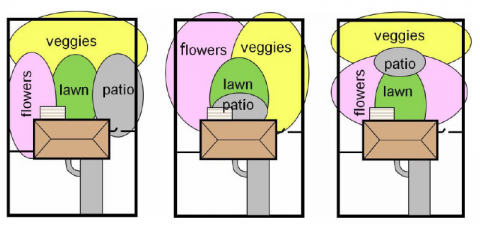- Home
- Admin
- Meetings
- Fry-Ark Project
- Projects
- Water Management
- Agriculture Conservation
- Arkansas River Basin Water Rights
- Conservation Plans
- Conservation & Education
- Education
- Fryingpan-Arkansas Project Water Import Tracking
- Inclusion into the Southeastern Colorado Water Conservancy District
- Legislation
- The Allocation of Fryingpan-Arkansas Project Water & Project Water Return Flows
- RRA
- Snow Pack Monitoring
- Water Conservation BMP Tool Box
- Winter Water Storage
- Water Wise Gardening
- Login
Xeriscape Gardening Information
Xeriscaping is an environmentally friendly way to “live green”. The increasing demands on water in the arid west makes xeriscaping one of the most practical methods to conserve water. Water wise landscapes can be both beautiful and functional, reflecting the dramatic natural landscapes found in the west. Xeriscaping is not a dry, dull, one size fits all style of garden design; rather it is the technique and art of selecting, grouping and watering plants appropriate to climate and soils. A xeric garden could be as natural and flowing as a “prairie garden” or as geometrical as a formal garden. It is all about the plants you use and how you choose to use them in your design. Xeriscaping includes an understanding of your specific climate, your soils and what plants will thrive within those parameters.
Efficient water use requires finding tactics to create and maintain attractive landscapes without excessive water consumption. In the western United States, more than fifty percent of residential water is used to keep traditional lawns and landscapes green. Xeriscaping can reduce this by up to 60% or more. Xeriscaping does not eliminate lawns, but it does incorporate more native and drought tolerant species of grasses and stresses irrigating them efficiently. Xeriscaping relies on an understanding of the natural environment and a good “sense of place”. Xeriscaping in the Pacific Northwest's wet, rainy, cool ocean climate is different than creating a xeric garden in the arid southwest but they would both use the same principles.
Seven Principles of Xeriscaping
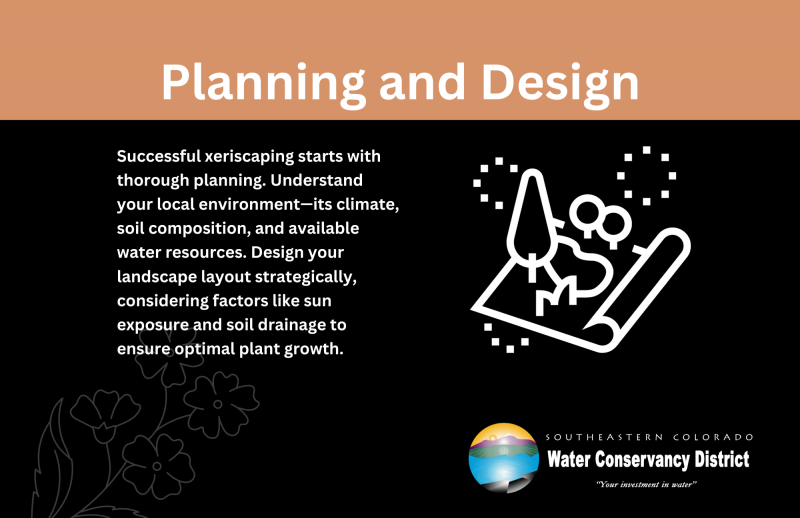
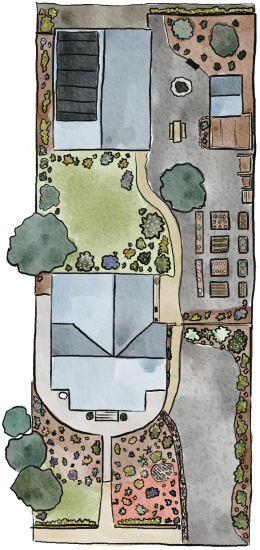 Before lifting a shovel or buying a plant it is best to take a little time and plan your water wise garden. This first step is crucial to creating a beautiful and cohesive garden. Anyone can create a plan. Here are the basic steps to drawing a rewarding design:
Before lifting a shovel or buying a plant it is best to take a little time and plan your water wise garden. This first step is crucial to creating a beautiful and cohesive garden. Anyone can create a plan. Here are the basic steps to drawing a rewarding design:
-
Create a base plan by drawing a simple scaled sketch of the property. Have someone help with measuring the exterior of buildings, existing features such as walkways, driveways, fence or property lines, and trees or shrubs that you want to retain in your final design.
-
After making a “wish list” of wanted items for your yard i.e. patio area, vegetable garden, play area, dog run, pond or utility storage area, prioritize your needs and begin a bubble diagram. By using tracing paper over your base map you can re-arrange these and experiment as much as needed. This bubble diagram should include the best views, sun exposure, slopes, and screening for unsightly views, as well as area functions. Remember to hydro-zone areas. Consider the watering needs to be highest nearer the house, this is called an “oasis” zone, then a moderate transition zone a little outside this “oasis” zone, and the lowest water use (most xeric) the farthest out.
-
Finalize your design by converting the best ideas from your bubble diagram to a well- defined plan drawn to scale. Identify hardscape details such as pathways, your planting scheme and the irrigation zones on this plan.
Planning your garden can be one of the most rewarding tasks to creating a beautiful and useful garden. Relax, dream and be creative.
Learn More:
Colorado State University Extension - Xeriscaping: Retrofit Your Yard
Colorado State University Extension - Sustainable Landscaping
Colorado State University Extension - Water Wise Landscape Design
Colorado Native Plant Society - Native Plant Gardening

Make sure you understand your existing soils by having a soil test done. Many labs are available to perform soil tests for the homeowner. Knowing your existing soils characteristics can save money in the long run by helping you choose the correct amendments to add to your soil or which plants would thrive in your specific soil type. Many xeric plants appreciate incorporated organic matter such as compost while most properly selected native plants need little to no amending.
Compost does more than just feed plants. In clay soils it can help aggregation which improves drainage and in sandy soils it can improve water holding capacity. For every 1% increase in organic matter in your soil, you increase water retention at a rate of 3 quarts per cubic foot.
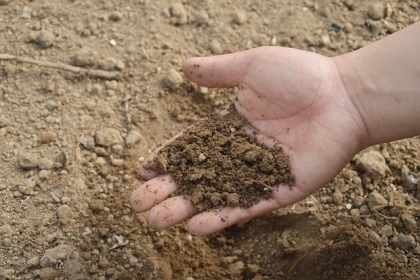
Learn More:
Colorado State University Extension - Soil Amendments
Oregon State University Extension - How to Use Compost
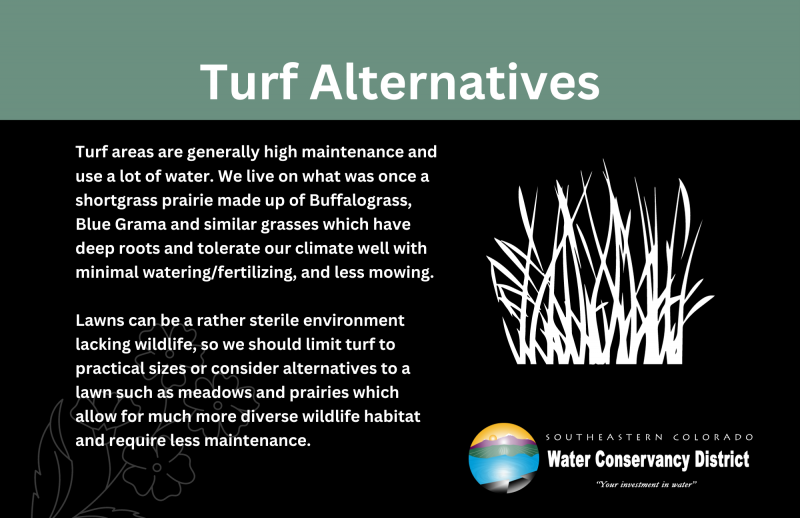
Xeriscaping does not “prohibit” lawns, but rather it advocates using a minimally useful amount of lawn in the landscape. Lawns should always be a practical size and have a purpose.
There are several benefits of creating a smaller turf area:
- Reduces water consumption
- Lowers lawn maintenance
- Less yard waste
- Reduces herbicide, pesticide, and fertilizer use
- Reduces air and noise pollution from power equipment
Alternatives to turf grass include shortgrass prairie, wildflower meadows and rock-crevice gardens. If you still want an area dedicated to lawn for purely aesthetic purposes, consider using native Buffalograss mixes which require less water.
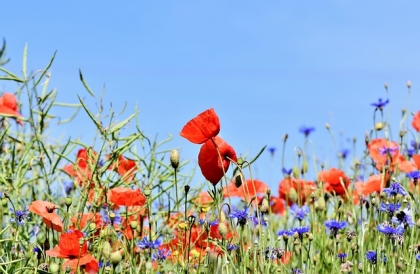
Learn More:
Utah State University Extension - Practical Turf Areas
Colorado State University Extension - Watering Established Lawns
Colorado State University Extension - Renovating the Home Lawn
Colorado State University Extension - Buffalograss Lawns
Colorado State University Extension - Sources of Seed, Sod, and Plugs
Colorado State University Extension - Xeriscape Turf and Alternatives
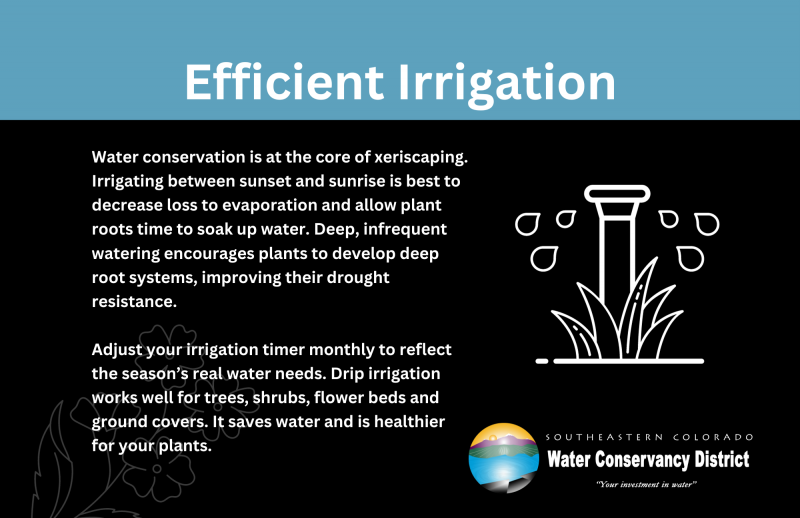
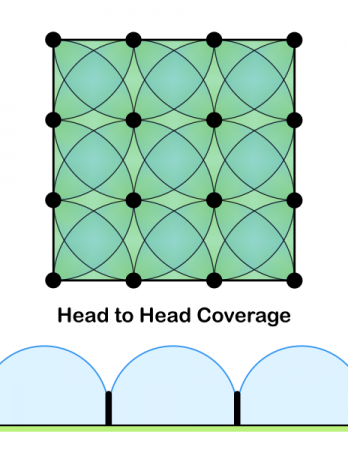
Plan the irrigation system carefully using hydro-zones to match plant water requirements with
irrigation zones which allows for a diverse selection of plants without wasting water. Hydro-zones are divided into groups such as moderate irrigation, low irrigation, very low irrigation and no irrigation, so plant accordingly. It is best to put the moderate water zone closest to the home, then have low water and very low water zones further out and no water zones along property lines.
Set your timer to run during the coolest part of the day, between 10 p.m. and 6 a.m. to reduce evaporation and don't irrigate under windy conditions. Adjust your irrigation to reflect seasonal temperature and precipitation fluctuations. Inspect the irrigation system as needed to make sure all parts are working correctly.
Native plants may require little to no irrigation once they are established, usually after the first or second year. Pueblo usually receives around 11-12 inches of precipitation annually so if you select plants accordingly you may only need to water during severe drought.
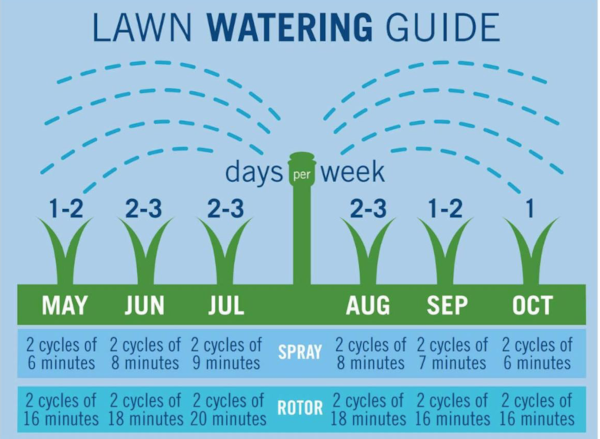
Learn More:
SECWCD - Lawn Watering Guide for Southeastern Colorado
Colorado State University Extension - Inspecting and Correcting Turf Irrigation Problems
Colorado State University Extension - Home Sprinkler Systems: Backflow Prevention Devices
Colorado State University Extension - Methods to Schedule Home Lawn Irrigation
Colorado State University Extension - Watering Efficiently
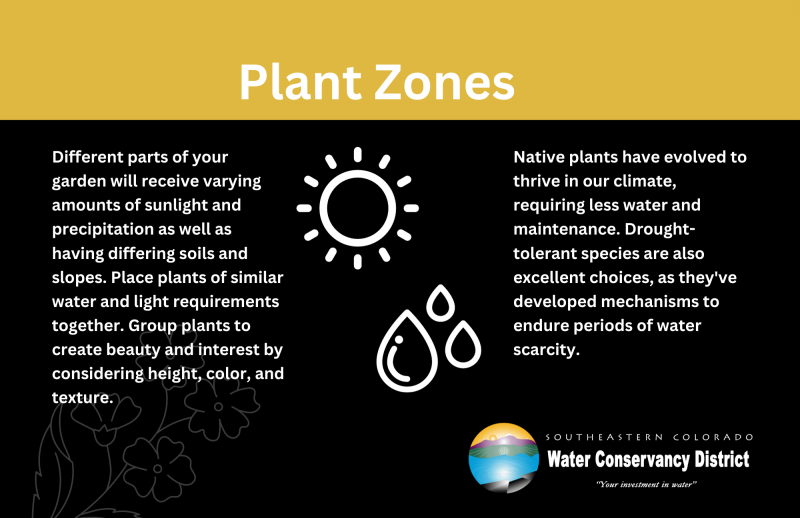

Most of eastern Colorado is part of an ecoregion known as a temperate steppe or shortgrass prairie. Being in the rain shadow of the Rocky Mountains leaves it with less precipitation and that means it is mostly devoid of trees except for near rivers and creeks. That means that most native plants require full sun and grow deep roots to survive drought. Our soils are usually on the alkaline side and primarily composed of clay, sand and gravel. Within this vast area are what are known as microclimates. These microclimates contain small but significant changes in climate that can affect your plants. During a garden's planning phase particular attention should be used to find areas where more water accumulates during rain and where sun and shade are during the changing seasons.
The sun's movement plays a key role in plant placement as well. South-facing areas will receive the most sun with the soil drying out the fastest so desert or steppe plants do best in that area. North-facing areas receive the least sun but retain water longer so it is an ideal place for montane or forest-edge plants. West-facing areas receive a half day of sun but it's during the afternoon when its hottest so it is similar to south-facing. East-facing areas also receive a half day of sun but it is during the cooler mornings so it can support a wider variety of plants.
Place trees to in correct locations to conserve energy in your home. Consider Landscaping for Energy Conservation to better understand tree placement. Use shrubs as screening for privacy or to block winds, as well as for seasonal interest like spring flowers, fall foliage and winter berries. Group plants with like water needs together.
There are a large variety of water wise plants for the arid west with more options available each year. Consider using natives plants in your gardenas they are best adapted for local soil, water, and climate conditions and have the added benefit of supporting native wildlife and pollinators.
Learn More:
New Mexico State University - Low Water-Use Landscape Plants for the Southwest
Colorado State University Extension - Native Shrubs for Colorado Landscapes
Colorado State University Extension - Xeriscaping: Ground Cover Plants
Colorado State University Extension - Native Herbaceous Perennials for Colorado
Colorado State University Extension - Native Trees for Colorado Landscapes
Plant Select
CSU Plant Database
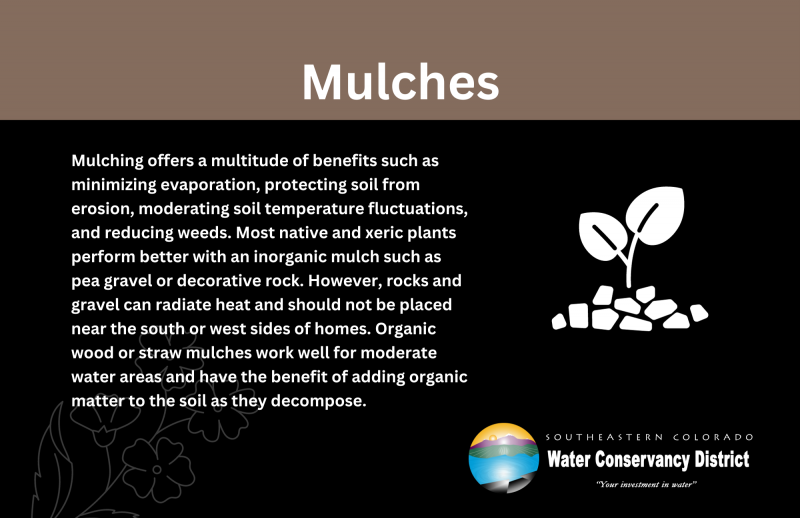
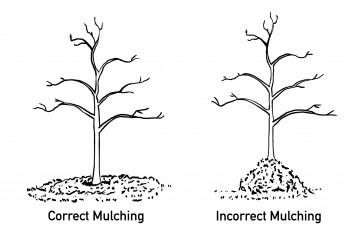
Mulches are extremely beneficial when applied on top of the soil to help retain moisture and control weeds while also moderating soil temperatures. Mulch should not be mounded up against tree trunks or the base of woody shrubs as it is unhealthy for them.
Organic mulches such as wood chips and straw help retain moisture and slowly break down, adding organic matter to soils through decomposition by micro-organisms and insects. This is helpful for plants that require more food and water.
Inorganic mulches such as pea gravel, decomposed granite and crusher fines are longer lasting and often more conducive to the growing needs of xeric and native plants. Rock mulches can enhance the color and textures in a garden and be a part of the overall design.
The moderate irrigation area closest to the home usually does best with organic mulches and lower irrigation areas further out are better for inorganic rock mulches. It is recommended to not use rock mulches too close to your home because it will store heat and cause a "heat-island" effect.
Organic Mulch:
Pros
- Breaks down and provides compost over time
- Retains water longer
- Moderates soil temperatures
- Reduces soil erosion
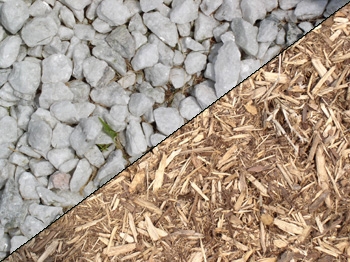
- Reduces weeds
Cons
- Can blow away in windy areas
- Needs to be replaced regularly
Inorganic Mulch:
Pros
- Longer lasting
- Can be used as part of a fire-break
- Wind-resistant
- Reduces soil erosion
- Reduces weeds
- Prevents rapid temperature fluctuations
Cons
- Raises soil temperature and radiates heat
- Faster evaporation due to heat
- More difficult to fertilize
Learn More:
Colorado State University Extension - Mulches for Home Grounds
Utah State University - Using Mulches
Xeric Garden Club of Albuquerque - What Mulch to Use
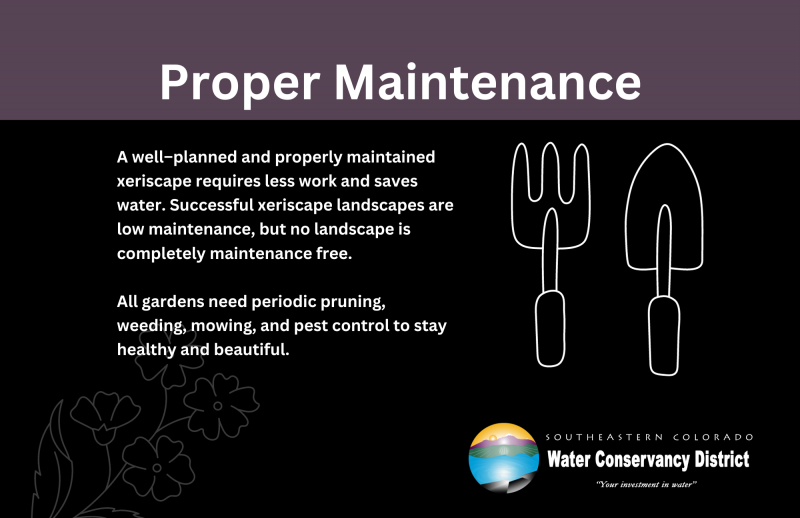
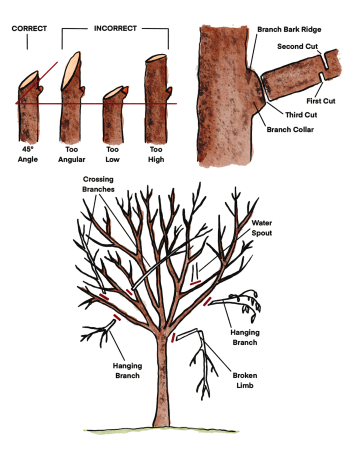
Maintaining your xeric garden will keep it healthy and beautiful. If designed properly these landscapes can be easier to maintain than traditional gardens. Xeric gardens do require some weeding, occasional pruning, pest management, and irrigation system maintenance.
When you add new plants to your garden they will require additional water during their first year as they get established. This is done to simulate nature's wet years, when there is enough rain to support new plants growing to maturity. During the first month after planting you should water 1-2 times per week or as the soil dries out and then after that they will need a weekly watering for the rest of the year. After the first year, depending on the plants you use you can cut back to monthly watering or even no supplemental watering. Annual fertilizing can benefit some plants but most native plants don't require it.
Native turf grasses like Buffalograss and Blue Grama can survive with no irrigation but will become brown and dormant in summer. To keep these lawns green during this period requires a deep watering of 1-2 inches every 2-4 weeks. Fertilizer should be added in May to mid-June and again in late July.
Heavy pruning of trees and shrubs should be done in late Winter when plants are dormant. It is best to not cut more than one-third of woody growth per year. Ornamental grasses and herbaceous plants should be cut back to near ground level in early Spring and it's also a good time to reapply organic mulches.
Learn More:

